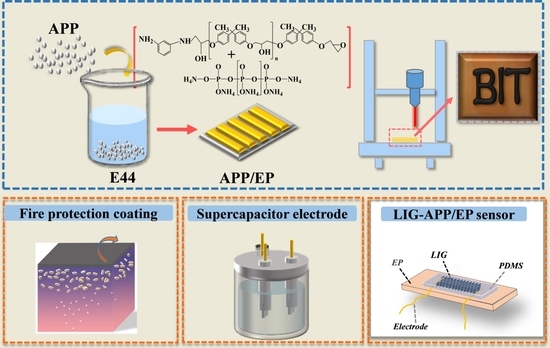An Intelligent Fire-Protection Coating Based on Ammonium Polyphosphate/Epoxy Composites and Laser-Induced Graphene
Abstract
1. Introduction
2. Materials and Methods
2.1. Preparation of LIG via Laser Scribing on APP/EP
2.2. Characterization of the LIG Formed on the APP/EP
2.3. Fabrication of a Supercapacitor Electrode and the Electrochemical Test
2.4. Fabrication of the LIG-APP/EP Sensors
2.5. Characterization of the LIG-APP/EP Sensor
3. Results
3.1. Surface Morphology and the Structure Characterization
3.2. Influence of the Flame-Retardant Performance and Laser Process Parameters on the LIG Formed on the APP/EP Composite
3.3. The Growth Mechanism of the LIG Formed on the APP/EP
3.4. The Application of a Fire-Protection Coating Based on the LIG Formed on the APP/EP
3.5. The Application of a Supercapacitor Electrode Based on the LIG Formed on the APP/EP
3.6. Application of the Temperature Sensor Based on the LIG Formed on the APP/EP
4. Conclusions
Supplementary Materials
Author Contributions
Funding
Institutional Review Board Statement
Informed Consent Statement
Data Availability Statement
Acknowledgments
Conflicts of Interest
References
- Feng, X.; Fan, J.; Li, A.; Li, G. Multireusable Thermoset with Anomalous Flame-triggered Shape Memory Effect. ACS Appl. Mater. Interfaces 2019, 11, 16075–16086. [Google Scholar] [CrossRef] [PubMed]
- Lin, B.; Yuen, A.C.; Li, A.; Zhang, Y.; Chen, T.B.; Yu, B.; Lee, E.W.; Peng, S.; Yang, W.; Lu, H.D.; et al. MXene/chitosan Nanocoating for Flexible Polyurethane Foam towards Remarkable Fire Hazards Reductions. J. Hazard. Mater. 2020, 381, 120952. [Google Scholar] [CrossRef] [PubMed]
- Zhou, K.; Liu, C.; Gao, R. Polyaniline: A Novel Bridge to Reduce the Fire Hazards of Epoxy Composites. Compos. Part A Appl. Sci. Manuf. 2018, 112, 432–443. [Google Scholar] [CrossRef]
- Zhu, Z.M.; Wang, L.X.; Lin, X.B.; Dong, L.P. Synthesis of a Novel Phosphorus-nitrogen Flame Retardant and its Application in Epoxy Resin. Polym. Degrad. Stab. 2019, 169, 108981. [Google Scholar] [CrossRef]
- Huang, C.; Chen, X.; Yuan, B.; Zhang, H.; Dai, H.; He, S.; Zhang, Y.; Niu, Y.; Shen, S. Suppression of Wood Dust Explosion by Ultrafine Magnesium Hydroxide. J. Hazard. Mater. 2019, 378, 120723. [Google Scholar] [CrossRef]
- Huang, Y.; Zhou, T.; He, S.; Xiao, H.; Dai, H.; Yuan, B.; Chen, X.; Yang, X. Flame-retardant Polyvinyl Alcohol/cellulose Nanofibers Hybrid Carbon Aerogel by Freeze Drying with Ultra-low Phosphorus. Appl. Surf. Sci. 2019, 497, 143775. [Google Scholar] [CrossRef]
- Huang, Y.; He, S.; Feng, M.; Dai, H.; Pan, Y.; Cheng, X. Organic Solvent-saving Preparation of Water Glass based Aerogel Granules under Ambient Pressure Drying. J. Non-Cryst. Solids 2019, 521, 119507. [Google Scholar] [CrossRef]
- Wang, D.; Feng, X.; Zhang, L.; Li, M.; Liu, M.; Tian, A.; Fu, S. Cyclotriphosphazene-bridged Periodic Mesoporous Organosilica-integrated Cellulose Nanofiber Anisotropic Foam with Highly Flame-retardant and Thermally Insulating Properties. Chem. Eng. J. 2019, 375, 121933. [Google Scholar] [CrossRef]
- Chen, D.Q.; Wang, Y.Z.; Hu, X.P.; Wang, D.Y.; Qu, M.H.; Yang, B. Flame-retardant and Anti-dripping Effects of a Novel Char-forming Flame Retardant for the Treatment of Poly (Ethylene Terephthalate) Fabrics. Polym. Degrad. Stab. 2005, 88, 349–356. [Google Scholar] [CrossRef]
- Xiao, Y.; Mu, X.; Wang, B.; Hu, W.; Wang, J.; Zhou, F.; Ma, C.; Hu, Y.; Song, L. A Novel Phosphorous-containing Polymeric Compatibilizer: Effective Reinforcement and Flame Retardancy in Glass Fiber Reinforced Polyamide 6 Composites. Compos. Part B Eng. 2021, 205, 108536. [Google Scholar] [CrossRef]
- Carja, I.D.; Serbezeanu, D.; Vlad-Bubulac, T.; Hamciuc, C.; Coroaba, A.; Lisa, G.; López, C.G.; Soriano, M.F.; Pérez, V.F.; Sánchez, M.D. A Straightforward, Eco-friendly and Cost-effective Approach towards Flame Retardant Epoxy Resins. J. Mater. Chem. A 2014, 2, 16230–16241. [Google Scholar] [CrossRef]
- Zhang, L.; Wang, Q.; Jian, R.K.; Wang, D.Y. Bioinspired Iron-loaded Polydopamine Nanospheres as Green Flame Retardants for Epoxy Resin via Free Radical Scavenging and Catalytic Charring. J. Mater. Chem. A 2020, 8, 2529–2538. [Google Scholar] [CrossRef]
- Wang, T.Y.; Zhang, B.Y.; Li, D.Y.; Hou, Y.C.; Zhang, G.X. A Single-Electron Tunneling Model: A Theoretical Analysis of a Metal Nanoparticle-doped Epoxy Resin to Suppress Surface Charge Accumulation on Insulators Subjected to DC Voltages. Nanotechnology 2020, 31, 475707. [Google Scholar] [CrossRef] [PubMed]
- Zhang, Y.; Hasegawa, K.; Kamo, S.; Takagi, K.; Takahara, A. Adhesion Enhancement of Poly (Etheretherketone) via Surface-initiated Photopolymerization of Glycidyl Methacrylate. Polymer 2020, 209, 122971. [Google Scholar] [CrossRef]
- Hu, L.; Pasta, M.; La Mantia, F.; Cui, L.; Jeong, S.; Deshazer, H.D.; Choi, J.W.; Han, S.M.; Cui, Y. Stretchable, Porous, and Conductive Energy Textiles. Nano Lett. 2010, 10, 708–714. [Google Scholar] [CrossRef] [PubMed]
- Liu, L.; Yu, Y.; Yan, C.; Li, K.; Zheng, Z. Wearable Energy-dense and Power-dense Supercapacitor Yarns Enabled by Scalable Graphene–metallic Textile Composite Electrodes. Nat. Commun. 2015, 6, 7260. [Google Scholar] [CrossRef]
- Ala, O.; Hu, B.; Li, D.; Yang, C.L.; Calvert, P.; Fan, Q. Conductive Textiles via Vapor-phase Polymerization of 3,4-Ethylenedioxythiophene. ACS Appl. Mater. Interfaces 2017, 9, 29038–29046. [Google Scholar] [CrossRef]
- Lee, J.; Kwon, H.; Seo, J.; Shin, S.; Koo, J.H.; Pang, C.; Son, S.; Kim, J.H.; Jang, Y.H.; Kim, D.E.; et al. Conductive Fiber-based Ultrasensitive Textile Pressure Sensor for Wearable Electronics. Adv. Mater. 2015, 27, 2433–2439. [Google Scholar] [CrossRef] [PubMed]
- Jian, M.; Wang, C.; Wang, Q.; Wang, H.; Xia, K.; Yin, Z.; Zhang, M.; Liang, X.; Zhang, Y. Advanced Carbon Materials for Flexible and Wearable Sensors. Sci. China Mater. 2017, 60, 1026–1062. [Google Scholar] [CrossRef]
- Wang, H.; Wang, C.; Jian, M.; Wang, Q.; Xia, K.; Yin, Z.; Zhang, M.; Liang, X.; Zhang, Y. Superelastic Wire-shaped Supercapacitor Sustaining 850% Tensile Strain based on Carbon Nanotube@Graphene Fiber. Nano Res. 2018, 11, 2347–2356. [Google Scholar] [CrossRef]
- Lee, C.; Wei, X.; Kysar, J.W.; Hone, J. Measurement of the Elastic Properties and Intrinsic Strength of Monolayer Graphene. Science 2008, 321, 385–388. [Google Scholar] [CrossRef] [PubMed]
- Javed, K.; Galib, C.M.; Yang, F.; Chen, C.M.; Wang, C. A New Approach to Fabricate Graphene Electro-conductive Networks on Natural Fibers by Ultraviolet Curing Method. Synth. Met. 2014, 193, 41–47. [Google Scholar] [CrossRef]
- Liu, W.W.; Yan, X.B.; Lang, J.W.; Peng, C.; Xue, Q.J. Flexible and Conductive Nanocomposite Electrode based on Graphene Sheets and Cotton Cloth for Supercapacitor. J. Mater. Chem. 2012, 22, 17245–17253. [Google Scholar] [CrossRef]
- Lin, J.; Peng, Z.W.; Liu, Y.; Ruiz-Zepeda, F.; Ye, R.Q.; Samuel, E.L.G.; Yacaman, M.J.; Yakobson, B.I.; Tour, J.M. Laser-Induced Porous Graphene Films from Commercial Polymers. Nat. Commun. 2014, 5, 5714. [Google Scholar] [CrossRef] [PubMed]
- Singh, S.P.; Li, Y.; Zhang, J.; Tour, J.M.; Arnusch, C.J. Sulfur-doped Laser-induced Porous Graphene Derived from Polysulfone-class Polymers and Membranes. ACS Nano 2018, 12, 289–297. [Google Scholar] [CrossRef]
- Yang, W.; Zhao, W.; Li, Q.; Li, H.; Wang, Y.; Li, Y.; Wang, G. Fabrication of Smart Components by 3D Printing and Laser-scribing Technologies. ACS Appl. Mater. Interfaces 2019, 12, 3928–3935. [Google Scholar] [CrossRef] [PubMed]
- Zhang, Z.; Song, M.; Hao, J.; Wu, K.; Li, C.; Hu, C. Visible Light Laser-Induced Graphene from Phenolic Resin: A New Approach for Directly Writing Graphene-Based Electrochemical Devices on Various Substrates. Carbon 2018, 127, 287–296. [Google Scholar] [CrossRef]
- Cançado, L.G.; Takai, K.; Enoki, T.; Endo, M.; Kim, Y.A.; Mizusaki, H.; Jorio, A.; Coelho, L.N.; Magalhaes-Paniago, R.; Pimenta, M.A. General Equation for the Determination of the Crystallite Size L a of Nanographite by Raman Spectroscopy. Appl. Phys. Lett. 2006, 88, 163106. [Google Scholar] [CrossRef]
- Ferrari, A.C.; Meyer, J.C.; Scardaci, V.; Casiraghi, C.; Lazzeri, M.; Mauri, F.; Piscanec, S.; Jiang, D.; Novoselov, K.S.; Roth, S.; et al. Raman Spectrum of Graphene and Graphene Layers. Phys. Rev. Lett. 2006, 97, 187401. [Google Scholar] [CrossRef]
- Malard, L.M.; Pimenta, M.A.; Dresselhaus, G.; Dresselhaus, M.S. Raman Spectroscopy in Graphene. Phys. Rep. 2009, 473, 51–87. [Google Scholar] [CrossRef]
- Chyan, Y.; Ye, R.; Li, Y.; Singh, S.P.; Arnusch, C.J.; Tour, J.M. Laser-induced Graphene by Multiple Lasing: Toward Electronics on Cloth, Paper, and Food. ACS Nano 2018, 12, 2176–2183. [Google Scholar] [CrossRef] [PubMed]
- Gu, J.W.; Zhang, G.C.; Dong, S.L.; Zhang, Q.Y.; Kong, J. Study on Preparation and Fire-retardant Mechanism Analysis of Intumescent Flame-retardant Coatings. Surf. Coat. Technol. 2007, 201, 7835–7841. [Google Scholar] [CrossRef]
- Zang, X.; Shen, C.; Chu, Y.; Li, B.; Wei, M.; Zhong, J.; Sanghadasa, M.; Lin, L. Laser-induced Molybdenum Carbide-graphene Composites for 3D Foldable Paper Electronics. Adv. Mater. 2018, 30, 1800062. [Google Scholar] [CrossRef] [PubMed]
- Hawes, J.F.; Yilara, D.; Noremberg, B.S.; Pope, M.A. Supercapacitors Fabricated via Laser-Induced Carbonization of Biomass-Derived Poly(furfuryl alcohol)/Graphene Oxide Composites. ACS Appl. Nano. Mater. 2019, 2, 6312–6324. [Google Scholar] [CrossRef]
- Schmidt, H.; Ihlemann, J.; Wolff-Rottke, B.; Luther, K.; Troe, J. Ultraviolet Laser Ablation of Polymers: Spot Size, Pulse Duration, and Plume Attenuation Effects Explained. J. Appl. Phys 1998, 83, 5458–5468. [Google Scholar] [CrossRef]
- Wang, H.; Wang, H.; Wang, Y.; Su, X.; Wang, C.; Zhang, M.; Jian, M.; Xia, K.; Liang, X.; Lu, H.; et al. Laser Writing of Janus Graphene/Kevlar Textile for Intelligent Protective Clothing. ACS Nano 2020, 14, 3219–3226. [Google Scholar] [CrossRef]
- Price, E.J.; Covello, J.; Tuchler, A.; Wnek, G.E. Intumescent, Epoxy-Based Flame-Retardant Coatings Based on Poly (Acrylic Acid) Compositions. ACS Appl. Mater. Interfaces 2020, 12, 18997–19005. [Google Scholar] [CrossRef]
- Sheng, L.; Jiang, H.; Liu, S.; Chen, M.; Wei, T.; Fan, Z. Nitrogen-doped Carbon-coated MnO Nanoparticles Anchored on Interconnected Graphene Ribbons for High-performance Lithium-ion Batteries. J. Power Sources 2018, 397, 325–333. [Google Scholar] [CrossRef]
- Wang, F.; Dong, X.; Wang, K.; Duan, W.; Gao, M.; Zhai, Z.; Zhu, C.; Wang, W. Laser-induced Nitrogen-doped Hierarchically Porous Graphene for Advanced Electrochemical Energy Storage. Carbon 2019, 150, 396–407. [Google Scholar] [CrossRef]
- Sun, L.; Wang, L.; Tian, C.; Tan, T.; Xie, Y.; Shi, K.; Li, M.; Fu, H. Nitrogen-doped Graphene with High Nitrogen Level via a One-step Hydrothermal Reaction of Graphene Oxide with Urea for Superior Capacitive Energy Storage. RSC Adv. 2012, 2, 4498–4506. [Google Scholar] [CrossRef]
- Zhang, C.; Mahmood, N.; Yin, H.; Liu, F.; Hou, Y. Synthesis of Phosphorus-doped Graphene and its Multifunctional Applications for Oxygen Reduction Reaction and Lithium Ion Batteries. Adv. Mater. 2013, 25, 4932–4937. [Google Scholar] [CrossRef]
- Zhuang, M.; Ou, X.; Dou, Y.; Zhang, L.; Zhang, Q.; Wu, R.; Ding, Y.; Shao, M.; Luo, Z. Polymer-embedded Fabrication of Co2P Nanoparticles Encapsulated in N,P-doped Graphene for Hydrogen Generation. Nano Lett. 2016, 16, 4691–4698. [Google Scholar] [CrossRef] [PubMed]
- Pivovarov, P.A.; Frolov, V.D.; Zavedeev, E.V.; Konov, V.i. Laser-induced modification of graphene in the presence of ethanol at the graphene - substrate interface. Quantum Electron. 2017, 47, 1017–1022. [Google Scholar] [CrossRef]
- El-Kady, M.F.; Strong, V.; Dubin, S.; Kaner, R.B. Laser Scribing of High-performance and Flexible Graphene-based Electrochemical Capacitors. Science 2012, 335, 1326–1330. [Google Scholar] [CrossRef] [PubMed]
- Beidaghi, M.; Wang, C. Micro-supercapacitors based on Interdigital Electrodes of Reduced Graphene Oxide and Carbon Nanotube Composites with Ultrahigh Power Handling Performance. Adv. Funct. Mater. 2012, 22, 4501–4510. [Google Scholar] [CrossRef]
- Huang, L.; Li, C.; Shi, G. High-performance and Flexible Electrochemical Capacitors based on Graphene/Polymer Composite Films. J. Mater. Chem. A 2014, 2, 968–974. [Google Scholar] [CrossRef]
- Wu, Z.S.; Parvez, K.; Feng, X.; Müllen, K. Graphene-based In-plane Micro-supercapacitors with High Power and Energy Densities. Nat. Commun. 2013, 4, 2487. [Google Scholar] [CrossRef]
- Wang, Y.; Yang, J.; Zhou, S.; Zhang, W.; Chuan, R. Electrical Properties of Graphene Nanoplatelets/Ultra-high Molecular Weight Polyethylene Composites. J. Mater. Sci. Mater. Electron. 2018, 29, 91–96. [Google Scholar] [CrossRef]
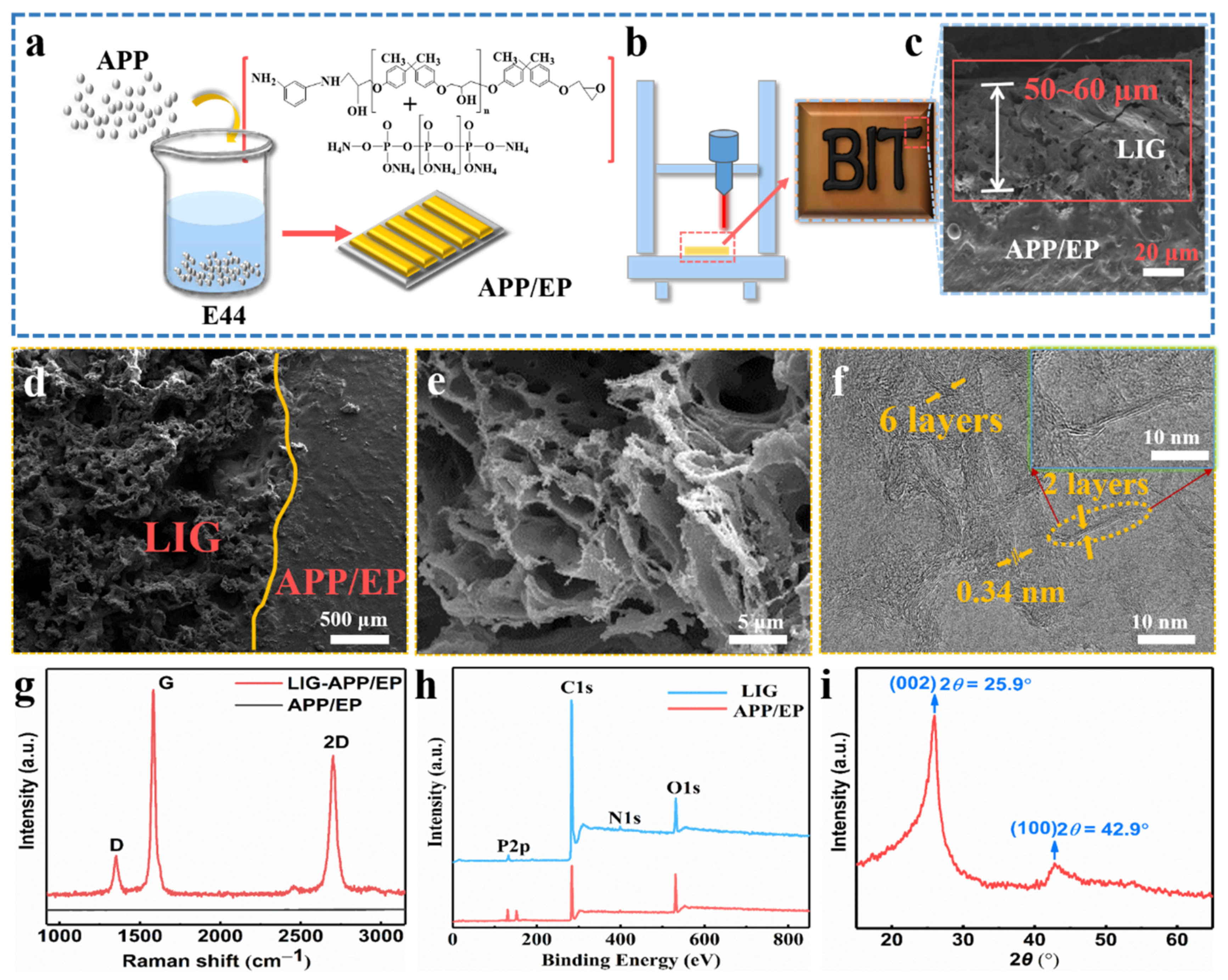
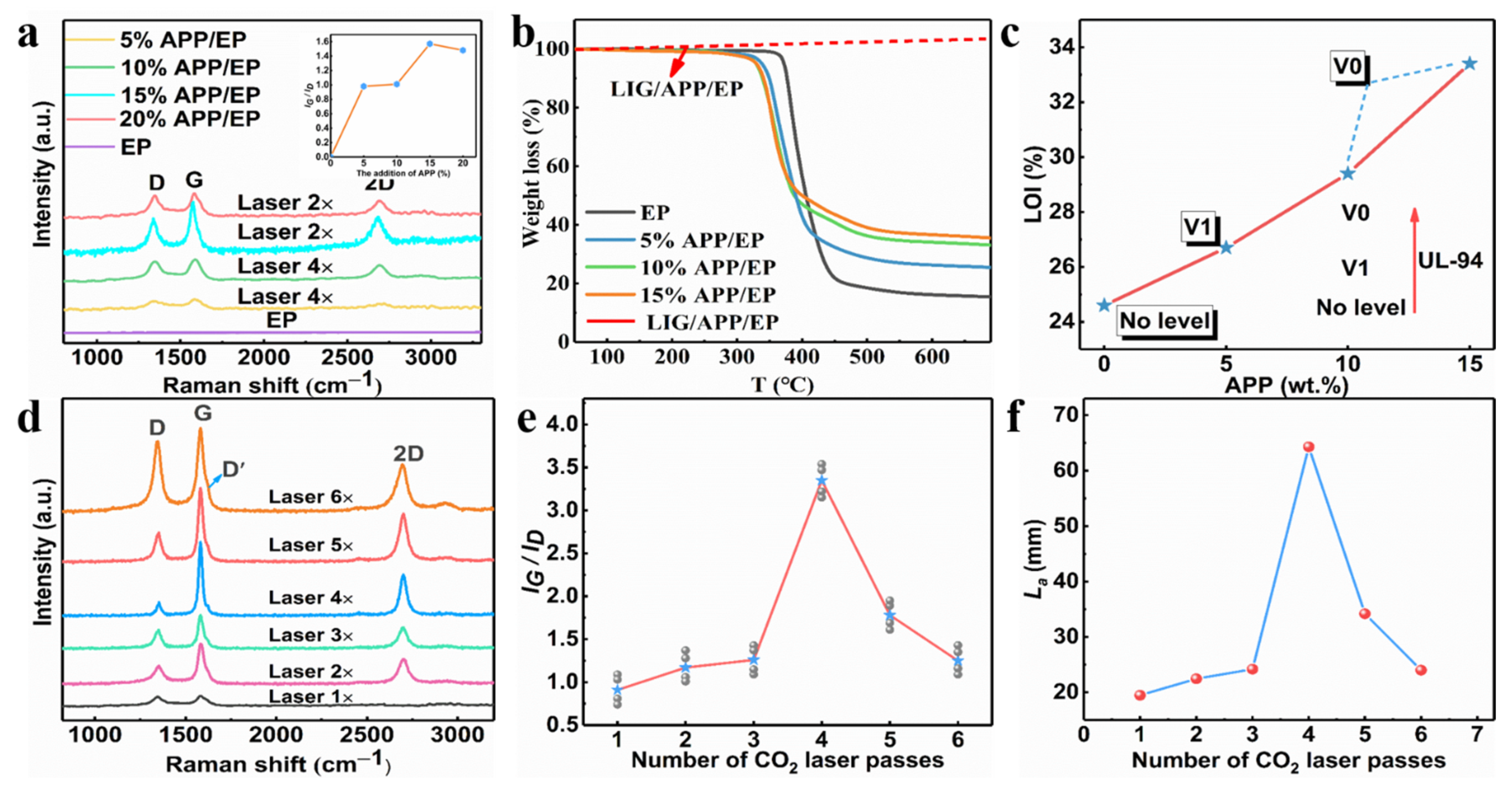
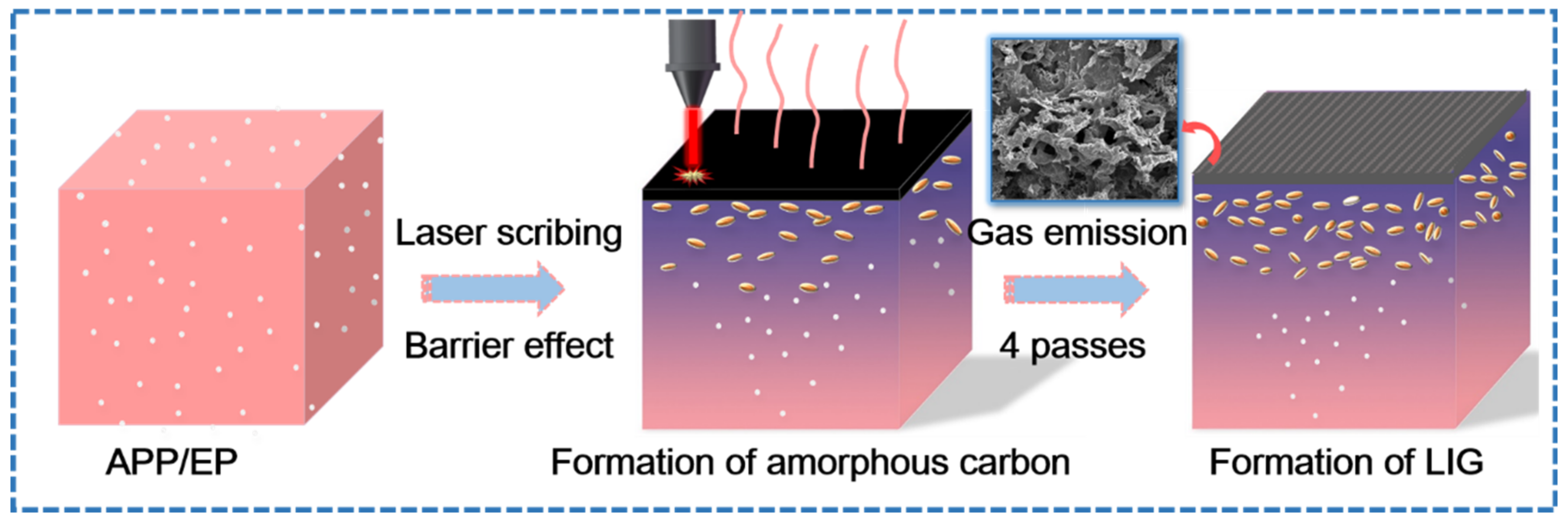
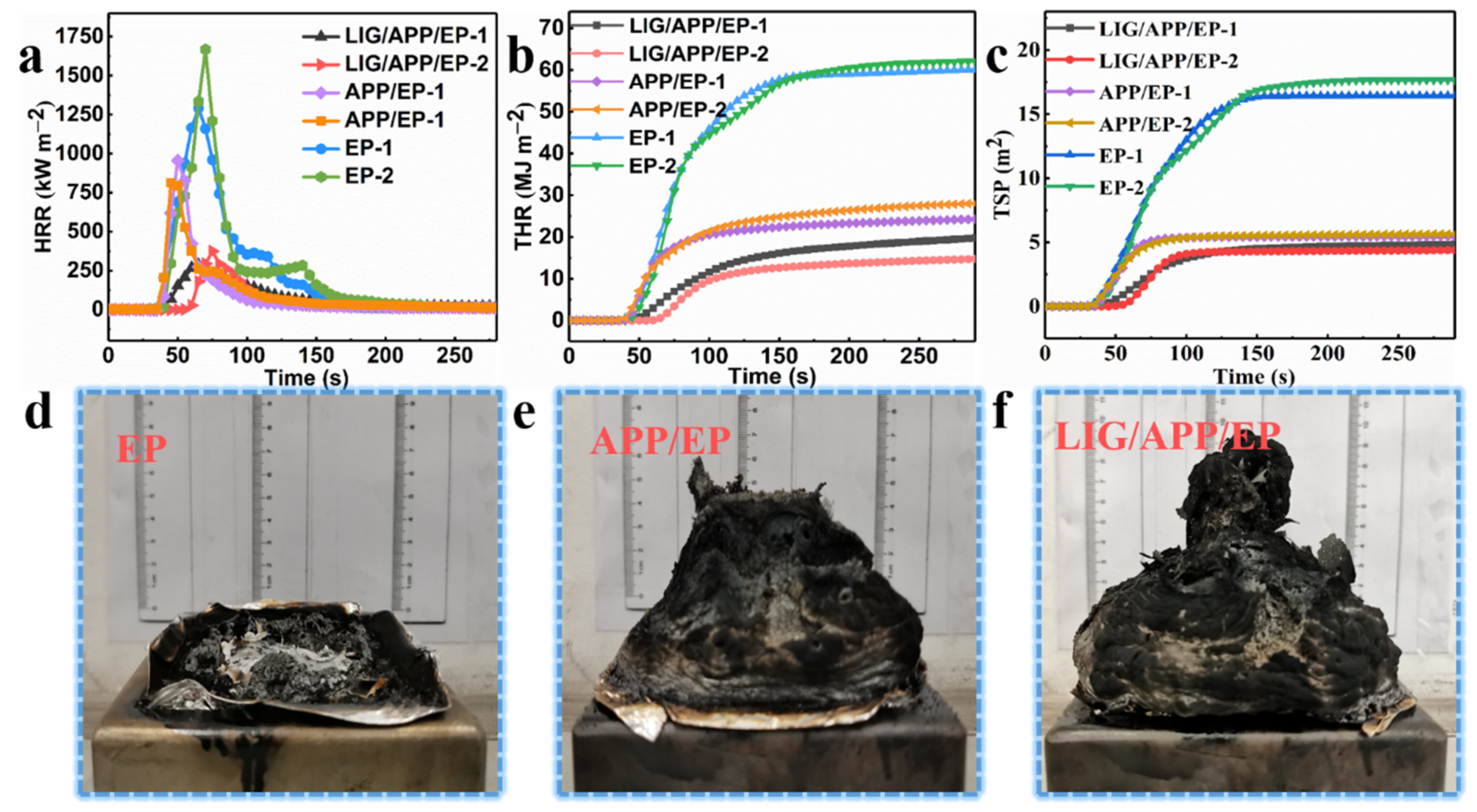
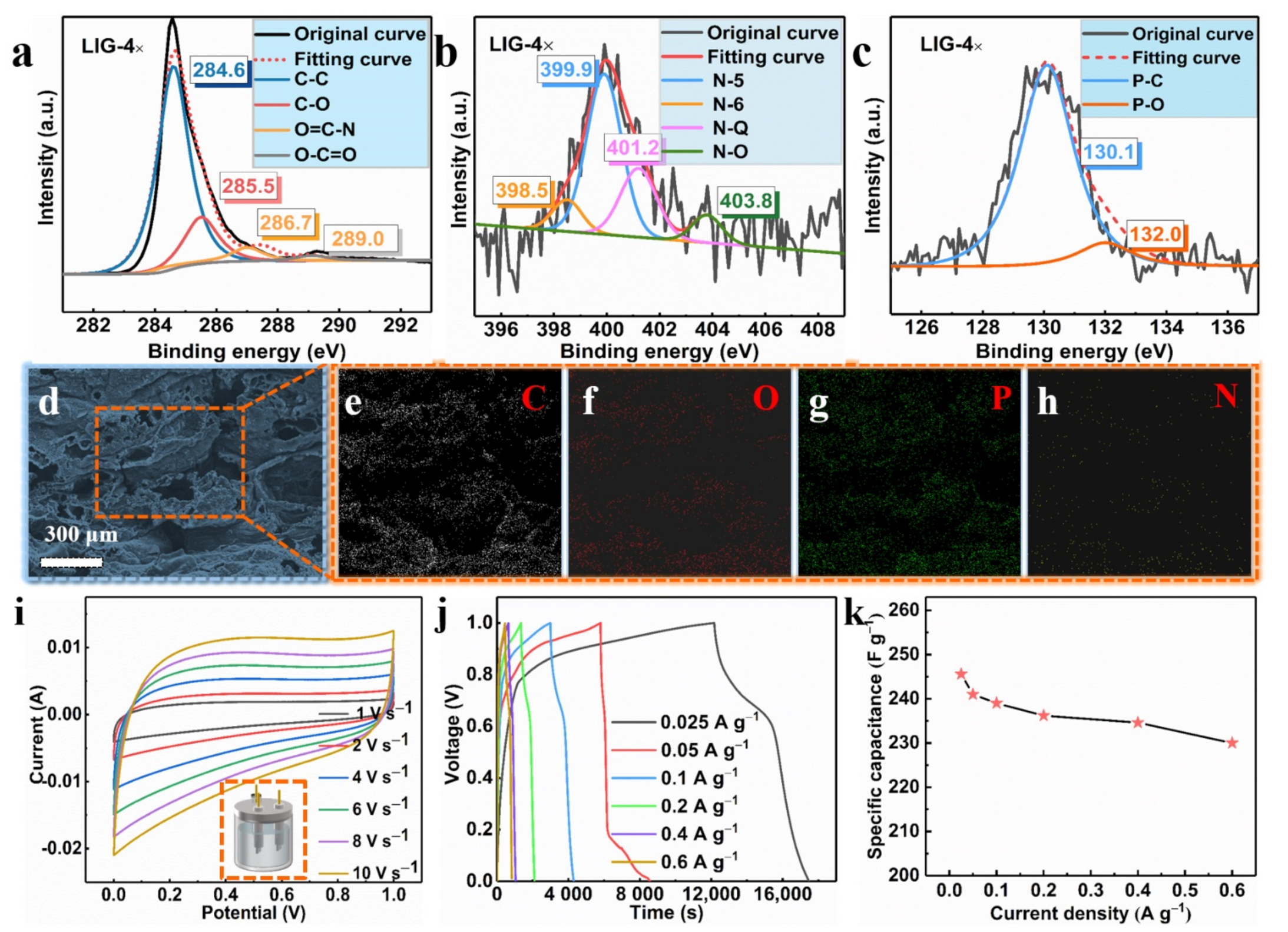

| Sample | TTI (s) | PHRR (kW·m−2) | THR (MJ·m−2) | TSP (m2) | SPR (m2·s−1) |
|---|---|---|---|---|---|
| LIG/APP/EP | 57 | 374.1 | 14.9 | 4.26 | 0.16 |
| LIG/APP/EP | 53 | 286.2 | 19.9 | 4.85 | 0.10 |
| APP/EP | 25 | 812.1 | 28.1 | 5.65 | 0.18 |
| APP/EP | 27 | 955.9 | 24.5 | 5.45 | 0.17 |
| EP | 21 | 1292.6 | 60.2 | 16.43 | 0.27 |
| EP | 23 | 1667.9 | 62.2 | 17.66 | 0.33 |
Publisher’s Note: MDPI stays neutral with regard to jurisdictional claims in published maps and institutional affiliations. |
© 2021 by the authors. Licensee MDPI, Basel, Switzerland. This article is an open access article distributed under the terms and conditions of the Creative Commons Attribution (CC BY) license (http://creativecommons.org/licenses/by/4.0/).
Share and Cite
Yang, W.; Liu, Y.; Wei, J.; Li, X.; Li, N.; Liu, J. An Intelligent Fire-Protection Coating Based on Ammonium Polyphosphate/Epoxy Composites and Laser-Induced Graphene. Polymers 2021, 13, 984. https://doi.org/10.3390/polym13060984
Yang W, Liu Y, Wei J, Li X, Li N, Liu J. An Intelligent Fire-Protection Coating Based on Ammonium Polyphosphate/Epoxy Composites and Laser-Induced Graphene. Polymers. 2021; 13(6):984. https://doi.org/10.3390/polym13060984
Chicago/Turabian StyleYang, Weiwei, Ying Liu, Jie Wei, Xueli Li, Nianhua Li, and Jiping Liu. 2021. "An Intelligent Fire-Protection Coating Based on Ammonium Polyphosphate/Epoxy Composites and Laser-Induced Graphene" Polymers 13, no. 6: 984. https://doi.org/10.3390/polym13060984
APA StyleYang, W., Liu, Y., Wei, J., Li, X., Li, N., & Liu, J. (2021). An Intelligent Fire-Protection Coating Based on Ammonium Polyphosphate/Epoxy Composites and Laser-Induced Graphene. Polymers, 13(6), 984. https://doi.org/10.3390/polym13060984





